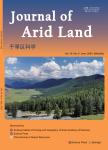Evaluating agricultural water-use efficiency based on water footprint of crop values: a case study in Xinjiang of China
Evaluating agricultural water-use efficiency based on water footprint of crop values: a case study in Xinjiang of China作者机构:State Key Laboratory of Simulation and Regulation of Water Cycle in River BasinChina Institute of Water Resources and Hydropower ResearchBeijing 100038China College of Water Conservancy and Architectural EngineeringShihezi UniversityShihezi 832003China Xinjiang Water Conservancy and Hydropower Planning and Design Management BureauUrumqi 830000China
出 版 物:《Journal of Arid Land》 (干旱区科学(英文版))
年 卷 期:2020年第12卷第4期
页 面:580-593页
核心收录:
学科分类:0710[理学-生物学] 0830[工学-环境科学与工程(可授工学、理学、农学学位)] 082802[工学-农业水土工程] 0709[理学-地质学] 08[工学] 0828[工学-农业工程] 0708[理学-地球物理学] 0815[工学-水利工程] 0705[理学-地理学]
基 金:supported by the National Key Technology Research and Development Program of China (2017YFC0404301, 2016YFA0601602) the National Natural Science Foundation of China (51479209) the Application Foundation Research Project of Xinjiang Production and Construction Corps (2016AG003) the Talent Initiate Scientific Research Project (RCZX2015027)。
主 题:agricultural input climatic factors contribution rate planting structure structural water-use coefficient water footprint of crop values
摘 要:Efficient agricultural water use is crucial for food safety and water conservation on a global scale. To quantitatively investigate the agricultural water-use efficiency in regions exhibiting the complex agricultural structure, this study developed an indicator named water footprint of crop values(WFV) that is based on the water footprint of crop production. Defined as the water volume used to produce a unit price of crop(m^3/CNY), the new indicator makes it feasible to directly compare the water footprint of different crops from an economic perspective, so as to comprehensively evaluate the water-use efficiency under the complex planting structure. On the basis of WFV, the study further proposed an indicator of structural water-use coefficient(SWUC), which is represented by the ratio of water-use efficiency for a given planting structure to the water efficiency for a reference crop and can quantitatively describe the impact of planting structure on agricultural water efficiency. Then, a case study was implemented in Xinjiang Uygur Autonomous Region of China. The temporal and spatial variations of WFV were assessed for the planting industries in 14 prefectures and cities of Xinjiang between 1991 and 2015. In addition, contribution rate analysis of WFV for different prefectures and cities was conducted to evaluate the variations of WFV caused by different influencing factors: agricultural input, climatic factors, and planting structure. Results from these analyses indicated first that the average WFV of planting industries in Xinjiang significantly decreased from 0.293 m^3/CNY in 1991 to 0.153 m^3/CNY in 2015, corresponding to an average annual change rate of –3.532%. WFV in 13 prefectures and cities(with the exception of Karamay) has declined significantly during the period of 1991–2015, indicating that agricultural water-use efficient has effectively improved. Second, the average SWUC in Xinjiang decreased from 1.17 to 1.08 m^3/CNY in the 1990 s, and then declined to 1.00 m^3/CNY in 2011–2015. The value of SWUC was highly consistent with the relative value of WFV in most prefectures and cities, showing that planting structure is one of the primary factors affecting regional agricultural water-use efficiency. Third, the contribution rate of WFV variations from human factors including agricultural input and planting structure was much more significant than that from climatic factors. However, the distribution of agricultural input and the adjustment of planting structure significantly differed among prefectures and cities, suggesting regional imbalances of agricultural development. This study indicated the feasibility and effectiveness of controlling agricultural water use through increasing technical input and rational selection of crops in the face of impending climate change. Specifically, we concluded that, the rational application of chemical fertilizers, the development of the fruit industry, and the strict restriction of the cotton industry should be implemented to improve the agricultural water-use efficiency in Xinjiang.



